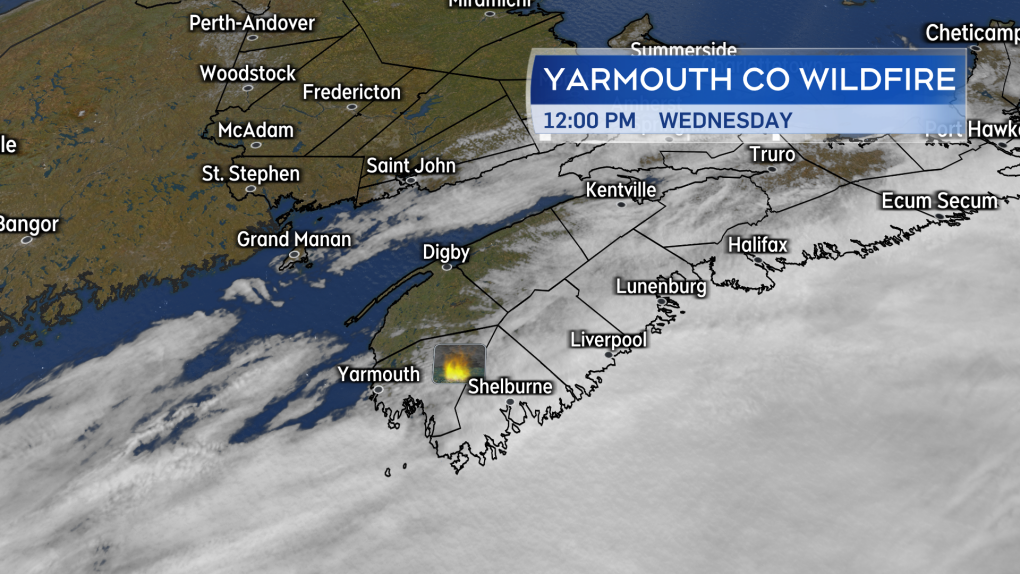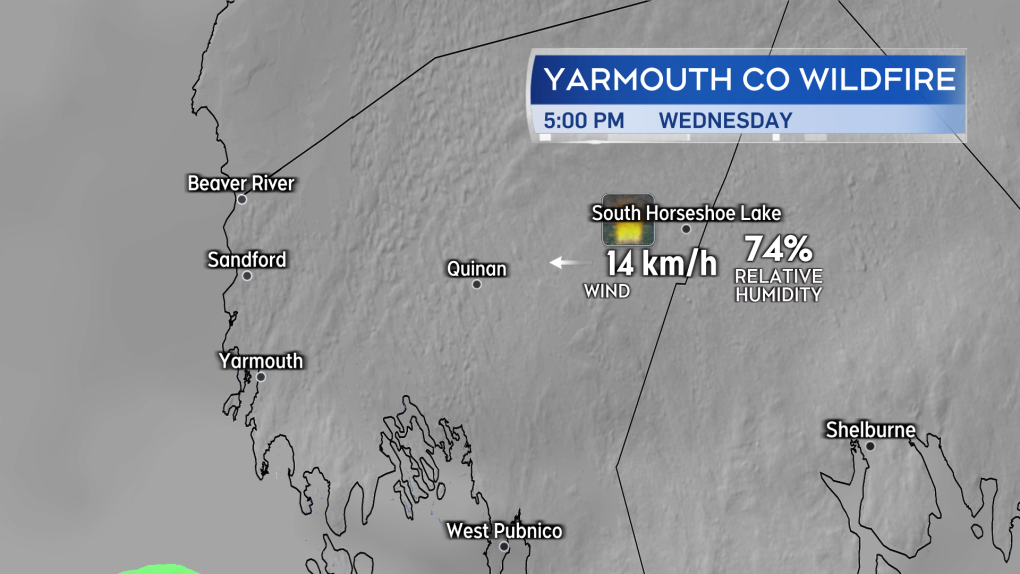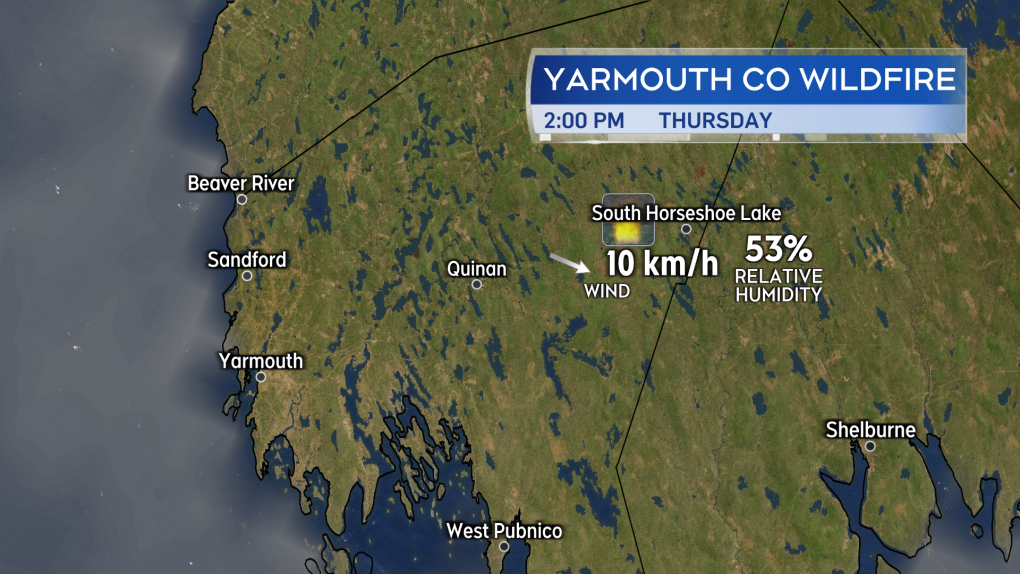Out-of-control wildfire in Yarmouth County triples in size; air quality alert remains in effect
An out-of-control wildfire in Nova Scotia's Yarmouth County has tripled in size since the Department of Natural Resource's last update Wednesday morning.
In a tweet just before 2:30 p.m. Wednesday, the department said the fire near Horseshoe Lake was estimated to cover 3,100 hectares of land. About five hours earlier, DNR said the fire was covering an estimated 1,000 hectares of land.
"This afternoon, because the smoke had eased a little bit, the pilots had a good chance to fly it a little better, and right now it's sitting at 3,100 hectares," said Kara McCurdy, the wildfire prevention officer with the Department of Natural Resources and Renewables.
According to DNR, two helicopters, 40 personnel from across the province and a CL-415 water bomber from Newfoundland and Labrador are working to contain the fire.
Crews have been fighting the wildfire since Monday. The water bomber arrived Tuesday night from Newfoundland and Labrador.
DNR first tweeted about the fire at 10:20 p.m. Monday. At the time, it said crews were responding to a wildfire about two kilometres west of South Horseshoe Lake, and that it was estimated to be about 50 hectares.
It has continued to spread since then.
McCurdy says winds and low humidity have made it difficult to control the spread and access the fire's remote location, which is mostly accessible by all-terrain vehicles or by walking.
"There's no way you can get a vehicle in there to fight the fire easily,” said McCurdy on Tuesday. “So, they're having to air-lift equipment in and personnel onto the fire.”
The cause of the fire remains under investigation, but McCurdy says they believe it started due to human action.
"Certainly, it is human-related," she said. "We are going to be investigating the fire as of tomorrow."
According to a news release from the province, the fire continues to approach Rushy Lake. However, due to how remote it is, it is not expected to reach homes or communities.
“The province's response is being managed by highly trained professionals and fire crew members who are ready to respond at a moment's notice to keep us safe in case of emergency,” said Natural Resources and Renewables Minister Tory Rushton in a news release. "As a former fire chief, I know they will protect our communities, homes, and forests."
The province says conditions across Nova Scotia are very dry and burning is not permitted in Shelburne, Yarmouth or Queens counties.
“April and May tend to be the busiest months of the fire season. Grass, brush and leaves dry very fast and make fuel for forest fires” said the Nova Scotia government in a statement Tuesday. “Coupled with low humidity and high winds, fires can spread quickly, and they can be difficult to get under control.”
Volunteer firefighter Andrew Doucette hasn't been battling the wildfire, but has been helping knock down smaller ones in the area around the village of Quinan, N.S.
"It’s dry. It’s because it hasn’t turned green yet, but at least the ground isn’t really dry, so it’s not burning deep into the ground, but it’s still sweeping," he said.
"It looks like a big pile of smoke over the horizon. At times you couldn't see too far off across the lake ... it was really cloudy with smoke. You could tell it was a big fire."
Burning is restricted in all other Nova Scotia counties until 7 p.m. Wednesday.
Nova Scotians are urged to check burn restrictions before starting a fire.
AIR QUALITY ALERT REMAINS IN EFFECT
An air quality statement issued by Environment Canada Tuesday remained in effect Wednesday for the Yarmouth County area.
Environment Canada said easterly winds would continue Wednesday, pushing the smoke to the west, which may lead to reduced air quality.
In a statement, the department cautions that people who are exposed to the smoke, may experience coughing, throat irritation, headaches or shortness of breath. Children, seniors, and those with cardiovascular or lung disease, such as asthma, are especially at risk.
The Yarmouth Regional Hospital has established an incident management team to monitor issues related to air quality. The team has met several times over the last few days and continues to monitor the fire and any smoke-related issues.
Katie Babin, a respiratory therapist at the hospital, says some individuals will be more susceptible to smoke-related issues than others.
"Obviously we have some concerns with the air quality," she said. "Anyone with COPD or chronic obstructive pulmonary disease and asthma as well."
WEATHER CONDITIONS IMPROVE FOR WILDFIRE RESPONSE
CTV Atlantic Chief Meteorologist Kalin Mitchell says weather conditions have improved slightly for combatting the wildfire Wednesday.
"A marine air mass moved into the province Tuesday night. This has turned the area cloudier, with an increase in the general level of moisture in the air," explained Mitchell.
 Air sourced off the Atlantic ocean moved into Nova Scotia Tuesday night. The result has been increased cloudiness, a low chance of showers, and higher relative humidity for Wednesday.
Air sourced off the Atlantic ocean moved into Nova Scotia Tuesday night. The result has been increased cloudiness, a low chance of showers, and higher relative humidity for Wednesday.
Mitchell said relative humidity Wednesday afternoon is running in the 65 to 75 per cent range, up from Tuesday, which was in the 20 to 30 per cent range in the afternoon.
He says there's also a low chance of a shower or drizzle Wednesday afternoon. However, it won’t bring enough rain to be of significant help.
Wind speed is down about five to 10 kilometres per hour from Tuesday. A further easing of the wind is forecast for Wednesday night.
 While five to 10 kilometres per hour lighter than Tuesday, a steady, easterly wind will blow into Wednesday evening. That wind eases to become light in the night.
While five to 10 kilometres per hour lighter than Tuesday, a steady, easterly wind will blow into Wednesday evening. That wind eases to become light in the night.
Mitchell's forecast for Thursday shows clearing in the morning, followed by mainly sunny conditions in the afternoon.
"Relative humidity will fall back to near 50 per cent," said Mitchell. "Wind will become northwest 10 to 20 kilometres per hour. The change in the wind direction means smoke will be blown towards Shelburne County Thursday."
 A clearing sky and fall in relative humidity is expected Thursday. The wind becomes northwest 10 to 20 kilometres per hour and should blow the smoke towards Shelburne County, N.S.
A clearing sky and fall in relative humidity is expected Thursday. The wind becomes northwest 10 to 20 kilometres per hour and should blow the smoke towards Shelburne County, N.S.
CTVNews.ca Top Stories

B.C. carjacking suspect sped across U.S. border before arrest, police say
Authorities have arrested a suspect who allegedly carjacked a pickup truck in B.C.'s Lower Mainland then sped across the U.S. border, triggering a massive police response.
Alberta premier says federal border plan coming Monday
The much-anticipated federal plan to address issues at the Canada-U.S. border will be unveiled on Monday according to Alberta Premier Danielle Smith.
Ottawa has sold its stake in Air Canada: sources
Two senior federal government sources have confirmed to CTV News that the federal government has sold its stake in Air Canada. During the COVID-19 pandemic in 2021, the government purchased a six per cent stake in the airline for $500 million as part of a bailout package.
Premiers disagree on whether Canada should cut off energy supply to U.S. if Trump moves ahead with tariffs
Some of Canada's premiers appeared to disagree with Ontario Premier Doug Ford on his approach to retaliatory measures, less than a day after he threatened to cut off the province's energy supply to the U.S. if president-elect Donald Trump follows through on his threat of punishing tariffs.
'Very concerned': Crews search B.C. ski resort for missing man
Police and rescue crews are searching for a man who was last seen boarding a ski lift at B.C.'s Sun Peaks Resort Tuesday.
Man who set fires inside Calgary's municipal building lost testicle during arrest: ASIRT
Two Calgary police officers have been cleared of any wrongdoing in an incident that saw a suspect lose a testicle after being shot with an anti-riot weapon.
Blizzard warning shuts down large parts of midwestern Ontario
It was a day to stay home, if you could, across much of midwestern Ontario due to weather.
Travis Vader, killer of Lyle and Marie McCann, denied day parole
The man who killed an Alberta couple in 2010 has been denied day parole.
She took a DNA test for fun. Police used it to charge her grandmother with murder in a cold case
According to court documents, detectives reopened the cold case in 2017 and then worked with a forensics company to extract DNA from Baby Garnet's partial femur, before sending the results to Identifinders International.

































